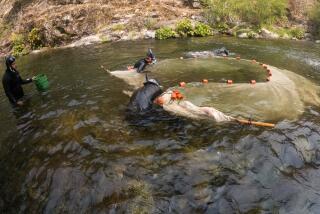Project Seeks to Save Flower, River
- Share via
WHITINGHAM, Vt. — Botanists Bob Roy and Georgia Hall recently spent two long days slogging through the slippery-rock, ankle-twisting stretch of the Deerfield River just below the Harriman Dam.
They were intent on preserving the tubercled orchid, a rare and threatened species that grows in greater abundance in the dry riverbed than anywhere else in Vermont.
Their efforts also were essential for restoring a minimum flow to the scenic river, a longtime goal of environmentalists.
In those two days, they covered three miles of river and found more than 500 of the orchids, their 6- to 8-inch leaves obscured among the thick vegetation that grows on the islands and riverbanks. They then marked the flowers’ locations by sticking a small pink flag in the silty soil beside each orchid or group of them--276 flags in all.
The 2-foot pieces of wire that support the flags are meant to stick up and be visible in the fall, when New England Power Co., which owns the dam, releases enough water from the reservoir to restore the Deerfield to what the utility, two states and 10 environmental groups have agreed will be the river’s minimum flow.
Then the river will be shut off again, while the botanists transplant the orchids that were low enough to disappear underwater to slightly higher ground. After that, the river will be restored for good.
How Hall and Roy came to be counting orchids in the nearly dry riverbed is a tale of compromise between conflicting environmental values: restoring a venerated river versus protecting a humble but rare and valued wildflower.
New England Power’s Harriman Dam is one of hundreds across the country whose 40-year licenses have come up for renewal before the Federal Energy Regulatory Commission since the early 1990s.
With new 40-year licenses being issued, environmentalists and state regulators have seized the opportunity to push for enforcement of a 1986 federal law that says hydropower interests must be balanced against those of fisheries, recreation and other river users.
In many instances, that has meant allowing more water to flow past, rather than through, utility powerhouses, meaning less electric generation but more water for fish, other aquatic life, canoeists and kayakers downstream.
At the Harriman Dam, one of 10 operated on the river by New England Power, a more than three-mile stretch of river is reduced to a trickle for much of the year as water is diverted from the reservoir behind the dam through a tunnel to a powerhouse downstream.
As the company’s 1993 dam relicensing approached, at the urging of the federal commission, environmental groups joined with the states of Vermont and Massachusetts to negotiate a settlement on the Deerfield’s future.
The talks resulted in a watershed agreement described by Interior Secretary Bruce Babbitt as a model for other river basins around the country.
But there was one hitch. In the riverbed below the Harriman and Searsburg dams were the largest collections of tubercled orchids in Vermont. The flower is protected by its status as “threatened” on the state’s endangered species list.
“It’s a funny thing because that orchid was probably not there naturally. You have a dam that dried up the river and allowed the orchid to invade,” said Ken Kimball, research director for the Appalachian Mountain Club, which was involved in the negotiations.
Jeff Cueto, chief hydrologist with the Vermont Department of Environmental Conservation, said the orchid “happens to be in a precarious position because it has colonized areas that in a natural river system wouldn’t be conducive to the plant growing there.”
Mike Thompson, a former Vermont fish and wildlife official who now heads up Woodlot Alternatives, the Topsham, Maine, environmental consulting firm for which the orchid-counting team works, said the orchids like to be underwater for a brief period in the spring. That’s why their favored habitat is not in a river but very near a river.
Roy said the move to slightly higher ground is intended to prevent year-round inundation of the orchids, which would rot their roots and kill them, without losing the dousing by spring floods that scours away competing species and enables the wildflowers to thrive.
For Kimball, the agreement on the river’s future is particularly important because it clears up the uncertainty that might otherwise cloud it, given the current climate of electric-industry deregulation and restructuring.
New England Power actually is looking to sell its dams around the region, those on the Deerfield included, as part of a restructuring effort. “What this settlement agreement does is help solidify the terms the new owner will have to live by,” Kimball said.
More to Read
Sign up for Essential California
The most important California stories and recommendations in your inbox every morning.
You may occasionally receive promotional content from the Los Angeles Times.













